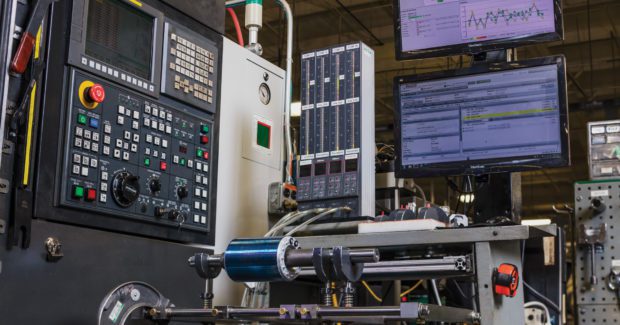Reducing Failure Costs with Air Gaging
Check out how Baldor switched from mechanical gaging to faster, more repeatable air gaging systems that improved their process capabilities, reduced their manufacturing costs, and improved the cycle times in their rotor machining cells.
Posted: December 29, 2016
Founded in 1920, Baldor Electric Company (Fort Smith, AR) is a leading manufacturer of industrial electric motors and mechanical power transmission products that are sold to distributors and original equipment manufacturers in more than 70 countries. As part of their continuous improvement process, they recently reached out to Mahr Federal Inc. (Providence, RI) to help identify opportunities to improve process capabilities within their machining cells. One of the goals of the project was to reduce failure costs on several components. After visiting several Baldor locations, the local district manager from Mahr Federal was able to suggest a number of gaging improvements, two of which resulted in the manufacturer switching from mechanical gaging to air gaging.
The first application involved the implementation of air snap gages, coupled with Millimar 1840 PE columns, across all rotor machining cells in five different North American facilities that had been checking rotor shaft diameters by using micrometers and mechanical snap gages. Replacing the old gages with the new air snap gages improved gage repeatability, reduced scrap, and allowed Baldor to provide a higher standard of quality to their customers. “We appreciated the ease of use with this system,” said Brandon Canclini, a corporate quality engineer at Baldor. “Such as being able to identify when a part is within tolerance by utilizing a series of brightly colored LEDs at various set points located on the display columns, as well as the way these new columns communicate with various SPC software. Being able to easily integrate SPC within manufacturing processes has always been desired to further understand process capabilities.”
The air snap gages allow the operator to check the parts while still mounted in the machine tool. This provided true in-process checking and instant correction if needed, without having to re-mount the part as with a post process gaging station. The shop also wanted better control of bearing bore diameters on electric motor housing endplates. They were using three-point mechanical bore gages to measure a part tolerance of .0007 in. A gage repeatability and reproducibility (GR&R) study revealed that it was extremely difficult to accurately measure this tolerance without overly securing the parts, and an opportunity to improve the roundness of the bores was also identified.
GR&R studies assess the reliability of gaging results. The study involves several gage operators measuring a small number of parts, several times each. The results are compiled and reduced to a single number that indicates the total expected spread of measurements for a single part, for all trials, by all operators. The number is presented as a percentage: a typical GR&R target of 10 percent means that all the results fall within a range equal to 10 percent of the allowable part tolerance. The best three-point mechanical gage tested for Baldor was only able to achieve a GR&R of 39 percent without tooling to secure the part. The jet air plug, in combination with the new column display, achieved a GR&R of 6.6 percent. The air jet plug combination improved the overall measurement system within the shop’s high volume environment and eliminated the need for excessive tooling to secure the part during inspection.
Because air gaging is manufactured specifically for the part size being measured, there is virtually no operator influence in the measurement. This means the results are faster and much more repeatable than with other variable gaging solutions. After this testing, five plants in North America that build the electric motors were converted to the air gages and column displays for checking the bearing bores. “These GR&R results meant less variation from operator to operator,” added Canclini. “They give us a much clearer picture of the process. Integrating this new system in all endplate machining cells across the whole company resulted in improved process capabilities, reduced manufacturing costs, and improved cycle times.”
Baldor Electric Company, 5711 R.S. Boreham Jr. Street, PO Box 2400, Fort Smith, AR 72901, 479-646-4711, Fax: 479-648-5792, www.baldor.com.
Mahr Federal Inc., 1144 Eddy Street, Providence, RI 02905, 401-784-3100, mkt.nafta@mahr.com, www.mahr.com.




